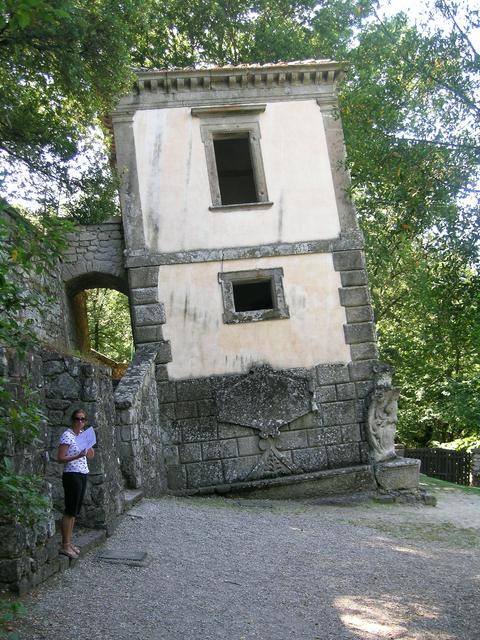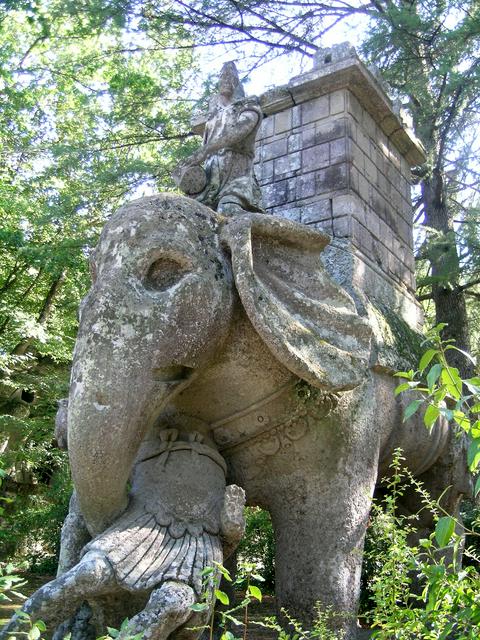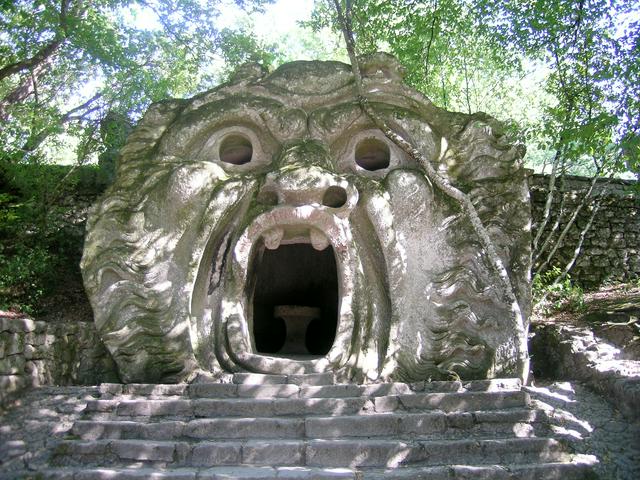Bomarzo is a small town in northern Lazio in Italy, famous for its park of stone monsters.

- Sacro Bosco. Apr-Aug 08:30-19:00; Sep-Mar 08:30-sunset. The Park of the Monsters is the main Bomarzo's attraction. It is also referred to as the Sacred Grove or Monsters' Grove. It contains many strange larger-than-life sculptures, sculpted in the large lumps of volcanic rock that littered the area. It was put together by Pier Francesco Orsini in the 1570s. The many monstrous statues have, in their time, entertained princes and princesses and provided inspiration for poets, novelists and painters, including Salvador Dali. There is even an opera called “Bomarzo”. Single €10, children (4 to 13 years) €8.
 During the 19th century and into the 20th the garden became overgrown and neglected, but in the 1970s a program of restoration was carried out. The garden is today a major tourist attraction and is guaranteed to entertain children who may be getting a bit fed up with medieval hill towns.
During the 19th century and into the 20th the garden became overgrown and neglected, but in the 1970s a program of restoration was carried out. The garden is today a major tourist attraction and is guaranteed to entertain children who may be getting a bit fed up with medieval hill towns.
Statues and fountains include Pegasus, Hannibal’s Elephants, an Orc, a dragon attacked by dogs, a turtle with a giant woman on its back, a two-tailed mermaid, a giant and Aphrodite, an ogre’s head as the “Mouth of Hell” and many more. There is also a strange little house which leans sharply to one side and is great fun to go inside. Carvings of acorns are all over the place, presumably a reference to the Della Rovere family that owned the local castle (Rovere meaning oak in Italian).
Sacro Bosco. Apr-Aug 08:30-19:00; Sep-Mar 08:30-sunset. The Park of the Monsters is the main Bomarzo's attraction. It is also referred to as the Sacred Grove or Monsters' Grove. It contains many strange larger-than-life sculptures, sculpted in the large lumps of volcanic rock that littered the area. It was put together by Pier Francesco Orsini in the 1570s. The many monstrous statues have, in their time, entertained princes and princesses and provided inspiration for poets, novelists and painters, including Salvador Dali. There is even an opera called “[[w:Bomarzo (opera)|Bomarzo]]”. Single €10, children (4 to 13 years) €8.
- Palazzo Orsini. A big Renaissance palace dominates the old part of the village. It doesn't seem to be open to the public but it's worth a have a bit of a walk once you're there.
Palazzo Orsini. A big Renaissance palace dominates the old part of the village. It doesn't seem to be open to the public but it's worth a have a bit of a walk once you're there.
- Riserva Naturale Monte Casoli di Bomarzo. The area which is not only rich in nature but also history left numerous traces here. At the top of the Monte Casoli hill it is still possible to see cavernous dwellings (l'abitato rupestre di Monte Casoli a Bomarzo) which used to be inhabited since Neolithic time to the Middle Ages. Walking further along the CAI 125 you'd also find remains of the Etruscan and Roman altars cut from the rock and the ruins of an old abbey.
- Piramide etrusca. Yet another Etruscan altar in a form of pyramid with steps carved from a top of a rock. Along the path leading to the Piramide you'd also come through a notable passage cut through the rock.
Riserva Naturale Monte Casoli di Bomarzo. The area which is not only rich in nature but also history left numerous traces here. At the top of the Monte Casoli hill it is still possible to see cavernous dwellings (l'abitato rupestre di Monte Casoli a Bomarzo) which used to be inhabited since Neolithic time to the Middle Ages. Walking further along the CAI 125 you'd also find remains of the Etruscan and Roman altars cut from the rock and the ruins of an old abbey.
Piramide etrusca. Yet another Etruscan altar in a form of pyramid with steps carved from a top of a rock. Along the path leading to the Piramide you'd also come through a notable passage cut through the rock.
The park has a souvenir shop.

There is a small restaurant attached to the park and a selection of restaurants in the nearby town.
- Villa Lante - A villa with another Mannerist (while more traditional) garden
- Giardino dei Tarocchi – a far more modern sculpture garden, which was partly inspired by Sacro Bosco
